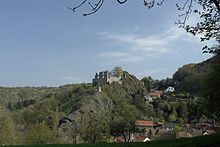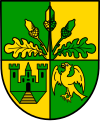Falkenstein (Palatinate)
| coat of arms | Germany map | |
|---|---|---|

|
Coordinates: 49 ° 36 ' N , 7 ° 52' E |
|
| Basic data | ||
| State : | Rhineland-Palatinate | |
| County : | Donnersbergkreis | |
| Association municipality : | Winnweiler | |
| Height : | 404 m above sea level NHN | |
| Area : | 7.49 km 2 | |
| Residents: | 179 (Dec. 31, 2019) | |
| Population density : | 24 inhabitants per km 2 | |
| Postal code : | 67808 | |
| Area code : | 06302 | |
| License plate : | KIB, ROK | |
| Community key : | 07 3 33 020 | |
| Association administration address: | Jakobstrasse 29 67722 Winnweiler |
|
| Website : | ||
| Local Mayor : | Volker Demmerle | |
| Location of the local community Falkenstein in the Donnersbergkreis | ||
Falkenstein is a municipality in the Donnersbergkreis in Rhineland-Palatinate . It belongs to the Winnweiler community , within which it is the smallest local community in terms of population.
geography
location
Falkenstein is located in the North Palatinate Bergland within the Falkenstein Mountains sub-area ; only the north of the district belongs to the Donnersberg massif and its subunit Western Donnersbergrandhöhen . The street village lies on an old pass road that reaches its apex at a height of 464 meters. With a 25 percent gradient, the main street is one of the steepest public roads in Germany. The Falkensteiner Tal, which is best known for its rock formations, opens up to the southwest of the village. The district is mostly wooded. In addition to the actual place, the district also includes a large weekend house area on a ridge between Appel and Alsenz valleys at an altitude of 400 to 480 meters. Neighboring communities are - clockwise - Rockenhausen , Imsbach , Winnweiler and Schweisweiler .
Surveys
The community is located in a deeply cut valley between the Bickberg ( 559 m above sea level ) in the south-east and the Schelmenberg ( 465 m above sea level ) in the north-west, both of which are southwestern foothills of the Donnersberg . The 488.1 meter high Schneid stretches to the north .
Waters
The central river of the community is the Falkensteiner Bach. The Appelbach rises in the extreme northeast of the district beyond the settlement area .
City structure
Falkenstein also includes the Bornshof, Fuchshof, Merzauerhof and Wambacherhof residential areas .
climate
The annual precipitation is 730 millimeters. The precipitation is in the middle tenth of the values recorded in Germany. Lower values are registered at 47 percent of the German Weather Service's measuring stations . The driest month is February, with the most rainfall in July. In July there is 1.7 times more rainfall than in February. The rainfall varies moderately. Lower seasonal fluctuations are recorded at 40 percent of the measuring stations .
history
The first documentary mention as "Falconolai" can be traced back to 891. In 1135 the castle was first mentioned in a document with the owner Sigebold von Falkenstein. In 1233 the castle was owned by Philip III. von Bolanden , who first called himself "Herr zu Falkenstein". He was Imperial Treasurer and Burgvogt on the Trifels and inherited the Landvogtei in the Wetterau in 1258 .
In 1456 the castle and rule were acquired by Wirich IV von Daun-Oberstein . He founded and operated the mines and smelting plants. In 1536, his grandson Wirich V. von Daun-Falkenstein strengthened the castle with fortifications and had it converted into a Renaissance castle.
During the Thirty Years' War in 1647 the castle was besieged, bombarded and stormed by the French. General Schönbeck then had it blown up with three mines. In 1654 Falkensteiner subjects stormed the building and shot the Lorraine commander Weingart. The last Count of Falkenstein, Wilhelm Wirich von Daun-Falkenstein , sold the impoverished county to Duke Charles IV of Lorraine in 1667 . Sixty years later, in 1736, through the marriage of Franz Stephan of Lorraine to Maria Theresa , the county came to the House of Austria-Lorraine . Since 1782 it has been administered as Oberamt Winnweiler by the front Austrian government in Freiburg im Breisgau .
From 1798 to 1814, when the Palatinate was part of the French Republic (until 1804) and then part of the Napoleonic Empire , the municipality was incorporated into the canton of Winnweiler . In 1815 the place belonged again to Austria as a result of the agreements made at the Congress of Vienna . A year later it was slammed into Bavaria . From 1818 to 1862 Falkenstein was part of the Land Commissioner in Kaiserslautern , which was then converted into a district office.
On December 1, 1900, the community moved to the newly created district office Rockenhausen . From 1939 the place was part of the district of Rockenhausen . After the Second World War , Steingruben became part of the then newly formed state of Rhineland-Palatinate within the French occupation zone . In 1961 the community had a total of 275 inhabitants. In the course of the first Rhineland-Palatinate administrative reform , the community moved to the newly created Donnersbergkreis. In 1972 it was added to the newly formed Winnweiler Association .
politics
Municipal council
The council in Falkenstein consists of six council members, who in the local elections on May 26, 2019 in a majority vote were elected, and the honorary mayor as chairman.
mayor
Volker Demmerle, who was not party to the party, became mayor of Falkenstein in 2009. In the direct election on May 26, 2019, he was confirmed in his office for another five years with a share of 72.22% of the votes.
Volker Demmerle's predecessors were Andreas Fischer (Mayor 2004–2009) and Josef Fischer (1989–2004).
coat of arms
| Blazon : “Square of green and gold; above three growing acorns with leaves in confused colors, below left a green tinned castle, below right a golden falcon. " | |
Attractions
Cultural monuments
The Falkenstein castle ruins and the Jewish cemetery are designated as monument zones.
The former is located above the village. It was partially restored from 1979 onwards. There is also the open-air stage with the adjoining "Burgstubb". The Gienanth family acquired the castle area, which later fell to the Rockenhausen district and the Donnersberg district via the North Palatinate History Association . The castle ruins have been owned by the municipality since 1996. Both 1978 and 1984 renovation measures were carried out on the castle ruins and they were placed under monument protection. After the foundation of the Burgförderverein, an open-air stage was opened in 1992 and a Kneipp facility in 1997 . In 2007 the Falkenstein Castle Hut was rebuilt.
In addition, there are a total of four individual objects that are under monument protection .
Other structures
The modern construction of the Catholic Church of St. Katharina was completed in 1976 and replaced a chapel from 1764. A Kneipp facility around 200 meters below the cemetery was opened in 1997.
nature
With the Falkensteiner Tal there is a natural monument in the municipality . In addition, the Schelmenkopf-Falkenstein nature reserve is within the boundaries of the municipality.
Economy and Infrastructure
traffic
The district road 37 connects the community to the road network. The B 48 , which also leads to the A 63 ( Kaiserslautern - Mainz ), runs west of Falkenstein . In Winnweiler there is a train station of the Alsenz Valley Railway .
tourism
The Donnersberg-Donon long-distance hiking trail marked with a red bar and two other hiking trails run through the municipality, one of which is marked with a yellow bar and the other with a green-yellow bar . The Palatinate High Trail also runs through the south of the district .
Personalities
Honorary citizen
- Josef Fischer (* 1940), master baker, local mayor from 1989 to 2004, after having been the first alderman for the community since 1974. In 2008 he was made an honorary citizen in gratitude for his commitment.
People who worked on site
- Kuno II. Von Falkenstein (~ 1320–1388), Archbishop and Elector of Trier
- Emich Christian von Leiningen-Dagsburg (1642–1702), Count of Leiningen and Dagsburg, married in 1664 on site
Web links
- Website of the local community Falkenstein
- Website of the former mayor Andreas Fischer with information about Falkenstein
- Pictures of Falkenstein Castle on Historische-orte.de
- Literature about Falkenstein in the Rhineland-Palatinate State Bibliography
Individual evidence
- ↑ State Statistical Office of Rhineland-Palatinate - population status 2019, districts, communities, association communities ( help on this ).
- ↑ State Statistical Office Rhineland-Palatinate (ed.): Official directory of the municipalities and parts of the municipality. Status: January 2019 [ Version 2020 is available. ] . S. 144 (PDF; 3 MB).
- ^ The Regional Returning Officer Rhineland-Palatinate: City Council Election 2019 Falkenstein. Retrieved September 2, 2019 .
- ↑ Sebastian Stollhof: Seven are no longer running. Die Rheinpfalz, January 25, 2019, accessed on May 26, 2020 .
- ↑ The State Returning Officer Rhineland-Palatinate: direct elections 2019. Retrieved on September 2, 2019 (see Winnweiler, Verbandsgemeinde, third line of results).
- ^ Twin cities of the city of Falkenstein. Visit 2006. City of Falkenstein / Vogtland, accessed on May 25, 2020 .
- ↑ a b Former local chief Josef Fischer turns 80. Die Rheinpfalz, April 27, 2020, accessed on May 25, 2020 .







